Shellharbour TAFE: Documentation, Planning & Assessment Record on Play
VerifiedAdded on 2023/06/08
|5
|1111
|334
Report
AI Summary
This report is a documentation, planning, and assessment record focusing on a work sample of a four-year-old child's painting activity. The report analyzes the child's cognitive and creative development, referencing Nilsen (2017) and the Early Years Learning Framework. It describes the child's actions during the painting process, interprets the skills demonstrated, and links these to theoretical perspectives, particularly Vygotsky's socio-cultural theory. The report highlights learning possibilities for curriculum inclusion, emphasizing the importance of providing children opportunities to express their creativity. The work sample includes references to various sources, including Daniels (2016), Stern (2017), and Gehris et al. (2015). The report also addresses the child's sense of identity and confidence during the creative process.
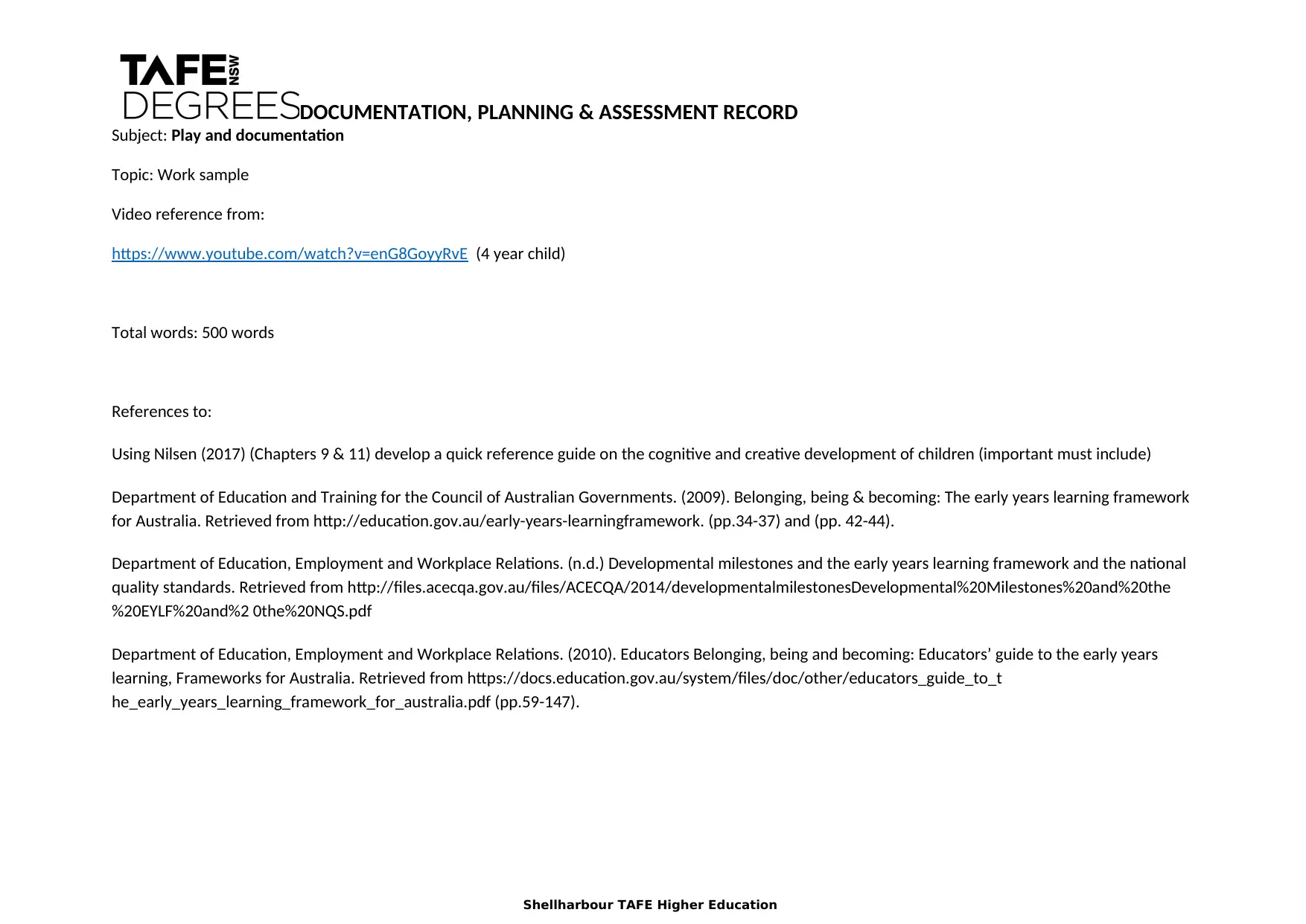
DOCUMENTATION, PLANNING & ASSESSMENT RECORD
Subject: Play and documentation
Topic: Work sample
Video reference from:
https://www.youtube.com/watch?v=enG8GoyyRvE (4 year child)
Total words: 500 words
References to:
Using Nilsen (2017) (Chapters 9 & 11) develop a quick reference guide on the cognitive and creative development of children (important must include)
Department of Education and Training for the Council of Australian Governments. (2009). Belonging, being & becoming: The early years learning framework
for Australia. Retrieved from http://education.gov.au/early-years-learningframework. (pp.34-37) and (pp. 42-44).
Department of Education, Employment and Workplace Relations. (n.d.) Developmental milestones and the early years learning framework and the national
quality standards. Retrieved from http://files.acecqa.gov.au/files/ACECQA/2014/developmentalmilestonesDevelopmental%20Milestones%20and%20the
%20EYLF%20and%2 0the%20NQS.pdf
Department of Education, Employment and Workplace Relations. (2010). Educators Belonging, being and becoming: Educators’ guide to the early years
learning, Frameworks for Australia. Retrieved from https://docs.education.gov.au/system/files/doc/other/educators_guide_to_t
he_early_years_learning_framework_for_australia.pdf (pp.59-147).
Shellharbour TAFE Higher Education
Subject: Play and documentation
Topic: Work sample
Video reference from:
https://www.youtube.com/watch?v=enG8GoyyRvE (4 year child)
Total words: 500 words
References to:
Using Nilsen (2017) (Chapters 9 & 11) develop a quick reference guide on the cognitive and creative development of children (important must include)
Department of Education and Training for the Council of Australian Governments. (2009). Belonging, being & becoming: The early years learning framework
for Australia. Retrieved from http://education.gov.au/early-years-learningframework. (pp.34-37) and (pp. 42-44).
Department of Education, Employment and Workplace Relations. (n.d.) Developmental milestones and the early years learning framework and the national
quality standards. Retrieved from http://files.acecqa.gov.au/files/ACECQA/2014/developmentalmilestonesDevelopmental%20Milestones%20and%20the
%20EYLF%20and%2 0the%20NQS.pdf
Department of Education, Employment and Workplace Relations. (2010). Educators Belonging, being and becoming: Educators’ guide to the early years
learning, Frameworks for Australia. Retrieved from https://docs.education.gov.au/system/files/doc/other/educators_guide_to_t
he_early_years_learning_framework_for_australia.pdf (pp.59-147).
Shellharbour TAFE Higher Education
Paraphrase This Document
Need a fresh take? Get an instant paraphrase of this document with our AI Paraphraser
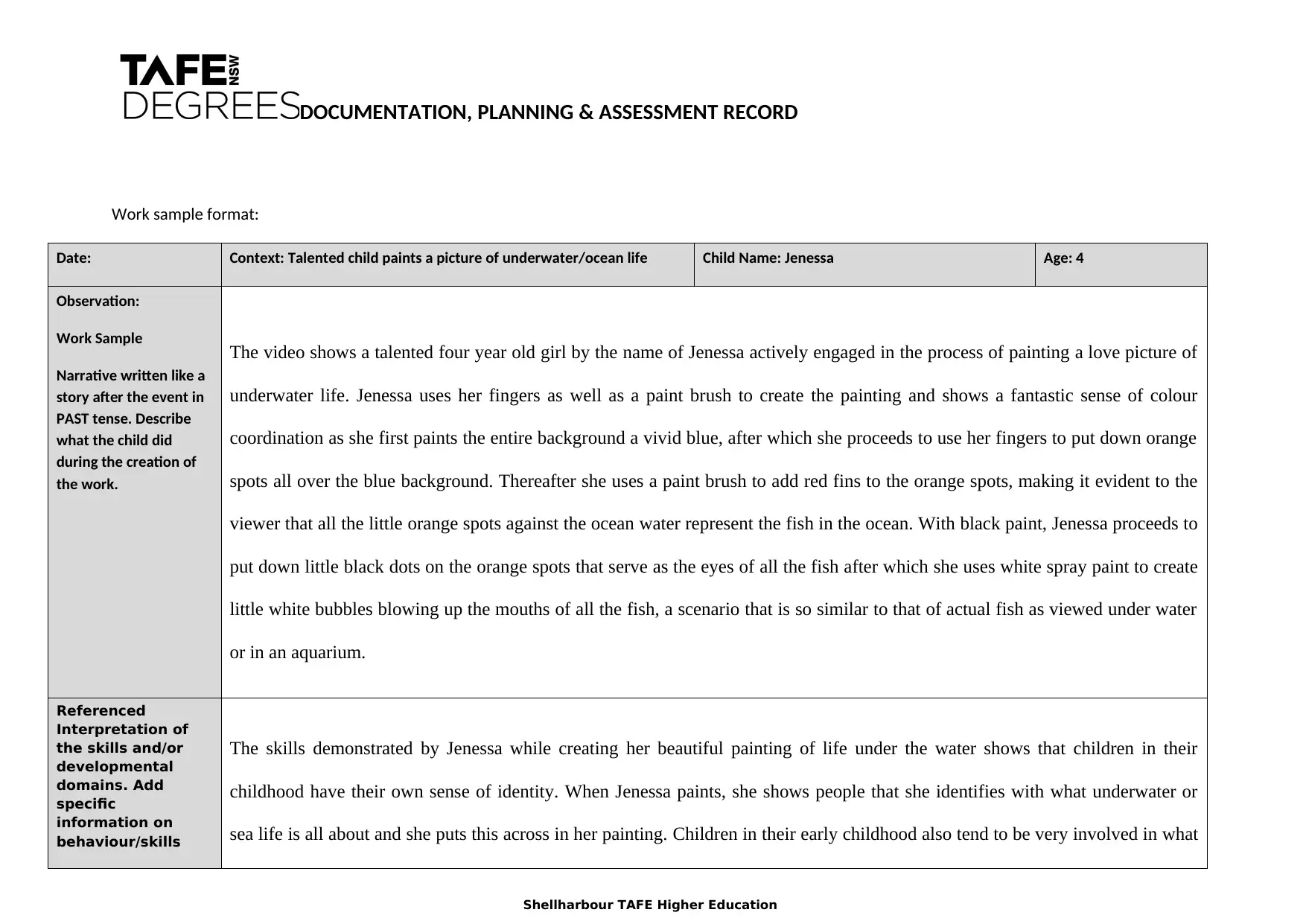
DOCUMENTATION, PLANNING & ASSESSMENT RECORD
Work sample format:
Date: Context: Talented child paints a picture of underwater/ocean life Child Name: Jenessa Age: 4
Observation:
Work Sample
Narrative written like a
story after the event in
PAST tense. Describe
what the child did
during the creation of
the work.
The video shows a talented four year old girl by the name of Jenessa actively engaged in the process of painting a love picture of
underwater life. Jenessa uses her fingers as well as a paint brush to create the painting and shows a fantastic sense of colour
coordination as she first paints the entire background a vivid blue, after which she proceeds to use her fingers to put down orange
spots all over the blue background. Thereafter she uses a paint brush to add red fins to the orange spots, making it evident to the
viewer that all the little orange spots against the ocean water represent the fish in the ocean. With black paint, Jenessa proceeds to
put down little black dots on the orange spots that serve as the eyes of all the fish after which she uses white spray paint to create
little white bubbles blowing up the mouths of all the fish, a scenario that is so similar to that of actual fish as viewed under water
or in an aquarium.
Referenced
Interpretation of
the skills and/or
developmental
domains. Add
specific
information on
behaviour/skills
The skills demonstrated by Jenessa while creating her beautiful painting of life under the water shows that children in their
childhood have their own sense of identity. When Jenessa paints, she shows people that she identifies with what underwater or
sea life is all about and she puts this across in her painting. Children in their early childhood also tend to be very involved in what
Shellharbour TAFE Higher Education
Work sample format:
Date: Context: Talented child paints a picture of underwater/ocean life Child Name: Jenessa Age: 4
Observation:
Work Sample
Narrative written like a
story after the event in
PAST tense. Describe
what the child did
during the creation of
the work.
The video shows a talented four year old girl by the name of Jenessa actively engaged in the process of painting a love picture of
underwater life. Jenessa uses her fingers as well as a paint brush to create the painting and shows a fantastic sense of colour
coordination as she first paints the entire background a vivid blue, after which she proceeds to use her fingers to put down orange
spots all over the blue background. Thereafter she uses a paint brush to add red fins to the orange spots, making it evident to the
viewer that all the little orange spots against the ocean water represent the fish in the ocean. With black paint, Jenessa proceeds to
put down little black dots on the orange spots that serve as the eyes of all the fish after which she uses white spray paint to create
little white bubbles blowing up the mouths of all the fish, a scenario that is so similar to that of actual fish as viewed under water
or in an aquarium.
Referenced
Interpretation of
the skills and/or
developmental
domains. Add
specific
information on
behaviour/skills
The skills demonstrated by Jenessa while creating her beautiful painting of life under the water shows that children in their
childhood have their own sense of identity. When Jenessa paints, she shows people that she identifies with what underwater or
sea life is all about and she puts this across in her painting. Children in their early childhood also tend to be very involved in what
Shellharbour TAFE Higher Education
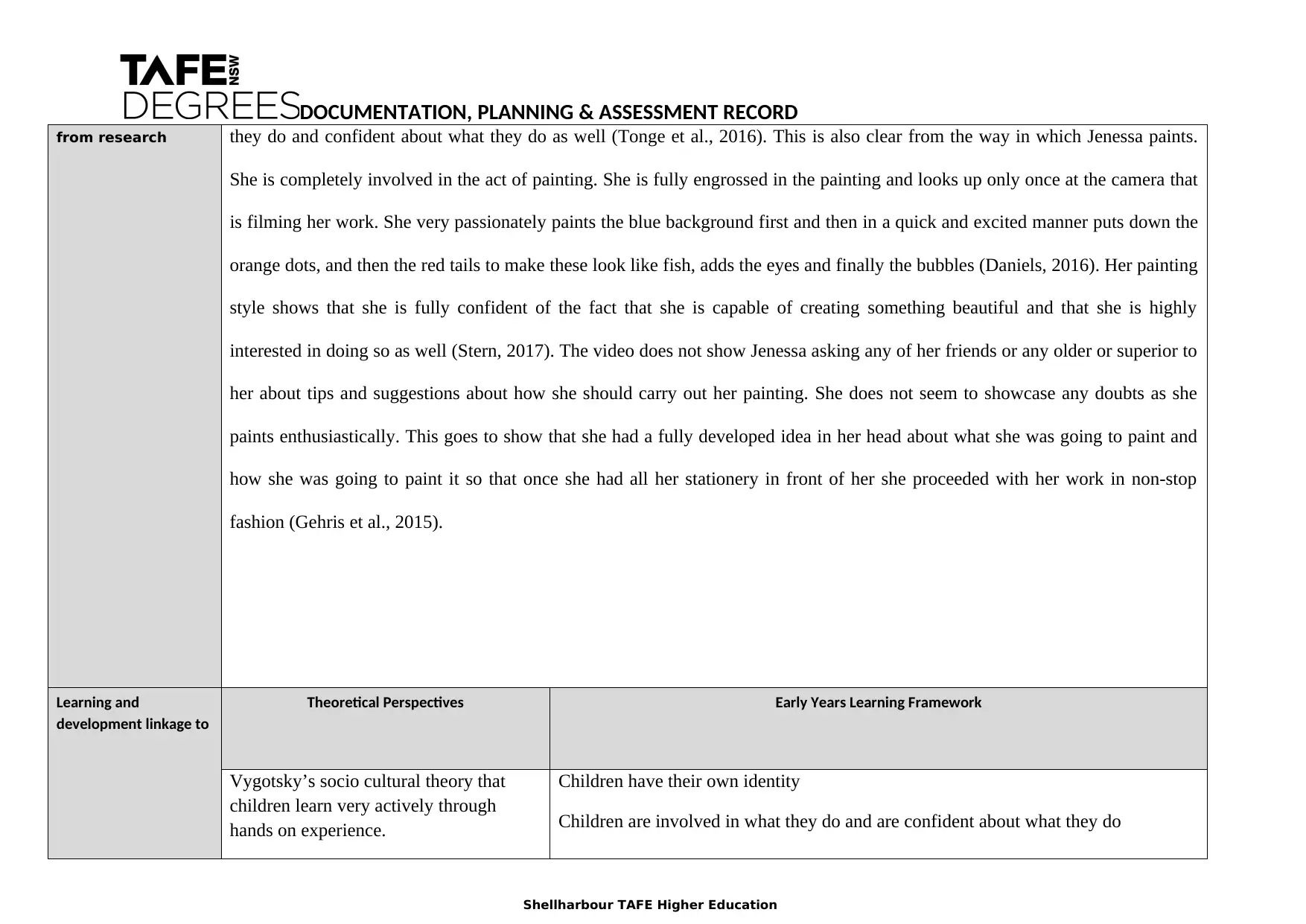
DOCUMENTATION, PLANNING & ASSESSMENT RECORD
from research they do and confident about what they do as well (Tonge et al., 2016). This is also clear from the way in which Jenessa paints.
She is completely involved in the act of painting. She is fully engrossed in the painting and looks up only once at the camera that
is filming her work. She very passionately paints the blue background first and then in a quick and excited manner puts down the
orange dots, and then the red tails to make these look like fish, adds the eyes and finally the bubbles (Daniels, 2016). Her painting
style shows that she is fully confident of the fact that she is capable of creating something beautiful and that she is highly
interested in doing so as well (Stern, 2017). The video does not show Jenessa asking any of her friends or any older or superior to
her about tips and suggestions about how she should carry out her painting. She does not seem to showcase any doubts as she
paints enthusiastically. This goes to show that she had a fully developed idea in her head about what she was going to paint and
how she was going to paint it so that once she had all her stationery in front of her she proceeded with her work in non-stop
fashion (Gehris et al., 2015).
Learning and
development linkage to
Theoretical Perspectives Early Years Learning Framework
Vygotsky’s socio cultural theory that
children learn very actively through
hands on experience.
Children have their own identity
Children are involved in what they do and are confident about what they do
Shellharbour TAFE Higher Education
from research they do and confident about what they do as well (Tonge et al., 2016). This is also clear from the way in which Jenessa paints.
She is completely involved in the act of painting. She is fully engrossed in the painting and looks up only once at the camera that
is filming her work. She very passionately paints the blue background first and then in a quick and excited manner puts down the
orange dots, and then the red tails to make these look like fish, adds the eyes and finally the bubbles (Daniels, 2016). Her painting
style shows that she is fully confident of the fact that she is capable of creating something beautiful and that she is highly
interested in doing so as well (Stern, 2017). The video does not show Jenessa asking any of her friends or any older or superior to
her about tips and suggestions about how she should carry out her painting. She does not seem to showcase any doubts as she
paints enthusiastically. This goes to show that she had a fully developed idea in her head about what she was going to paint and
how she was going to paint it so that once she had all her stationery in front of her she proceeded with her work in non-stop
fashion (Gehris et al., 2015).
Learning and
development linkage to
Theoretical Perspectives Early Years Learning Framework
Vygotsky’s socio cultural theory that
children learn very actively through
hands on experience.
Children have their own identity
Children are involved in what they do and are confident about what they do
Shellharbour TAFE Higher Education
⊘ This is a preview!⊘
Do you want full access?
Subscribe today to unlock all pages.

Trusted by 1+ million students worldwide
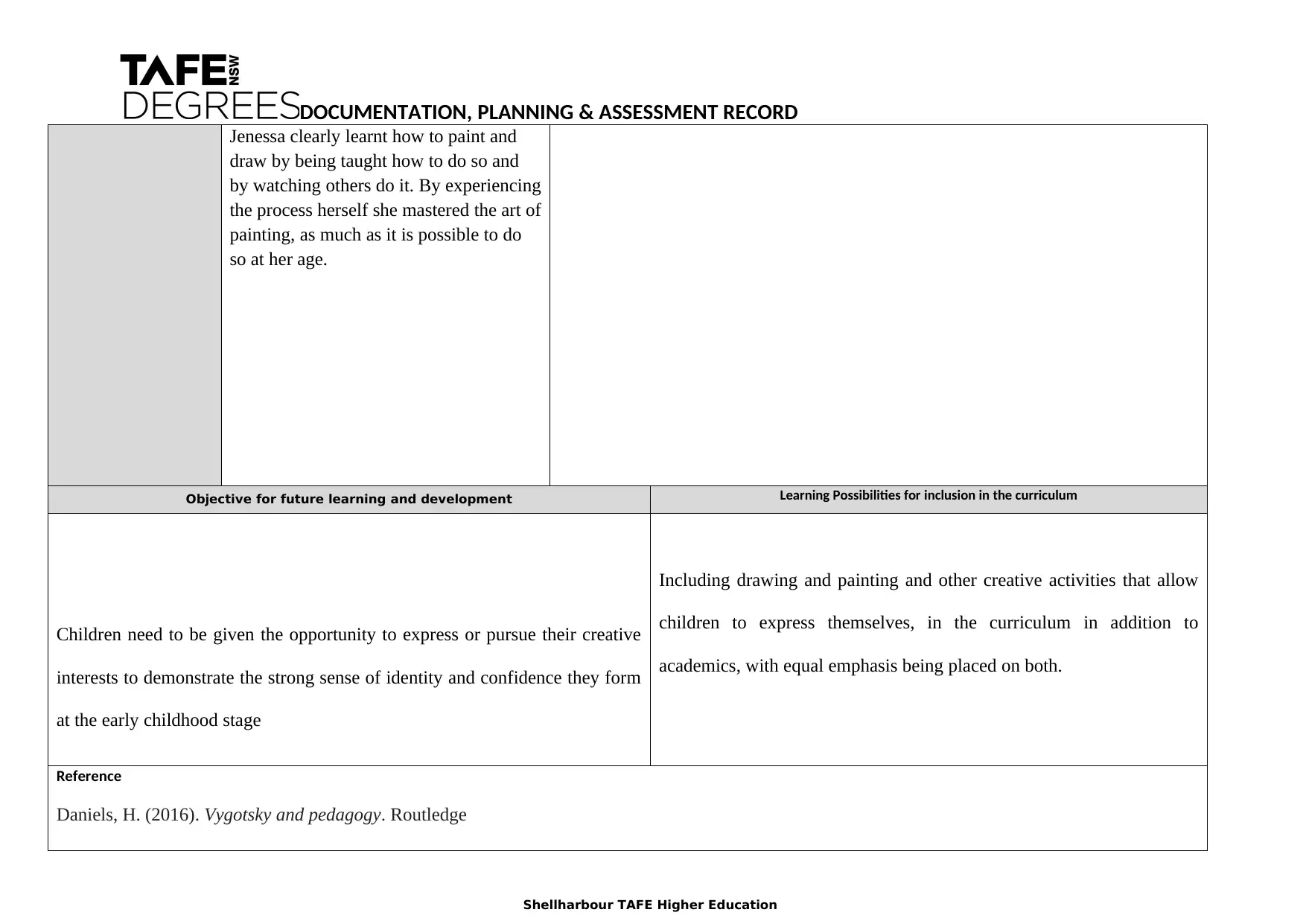
DOCUMENTATION, PLANNING & ASSESSMENT RECORD
Jenessa clearly learnt how to paint and
draw by being taught how to do so and
by watching others do it. By experiencing
the process herself she mastered the art of
painting, as much as it is possible to do
so at her age.
Objective for future learning and development Learning Possibilities for inclusion in the curriculum
Children need to be given the opportunity to express or pursue their creative
interests to demonstrate the strong sense of identity and confidence they form
at the early childhood stage
Including drawing and painting and other creative activities that allow
children to express themselves, in the curriculum in addition to
academics, with equal emphasis being placed on both.
Reference
Daniels, H. (2016). Vygotsky and pedagogy. Routledge
Shellharbour TAFE Higher Education
Jenessa clearly learnt how to paint and
draw by being taught how to do so and
by watching others do it. By experiencing
the process herself she mastered the art of
painting, as much as it is possible to do
so at her age.
Objective for future learning and development Learning Possibilities for inclusion in the curriculum
Children need to be given the opportunity to express or pursue their creative
interests to demonstrate the strong sense of identity and confidence they form
at the early childhood stage
Including drawing and painting and other creative activities that allow
children to express themselves, in the curriculum in addition to
academics, with equal emphasis being placed on both.
Reference
Daniels, H. (2016). Vygotsky and pedagogy. Routledge
Shellharbour TAFE Higher Education
Paraphrase This Document
Need a fresh take? Get an instant paraphrase of this document with our AI Paraphraser
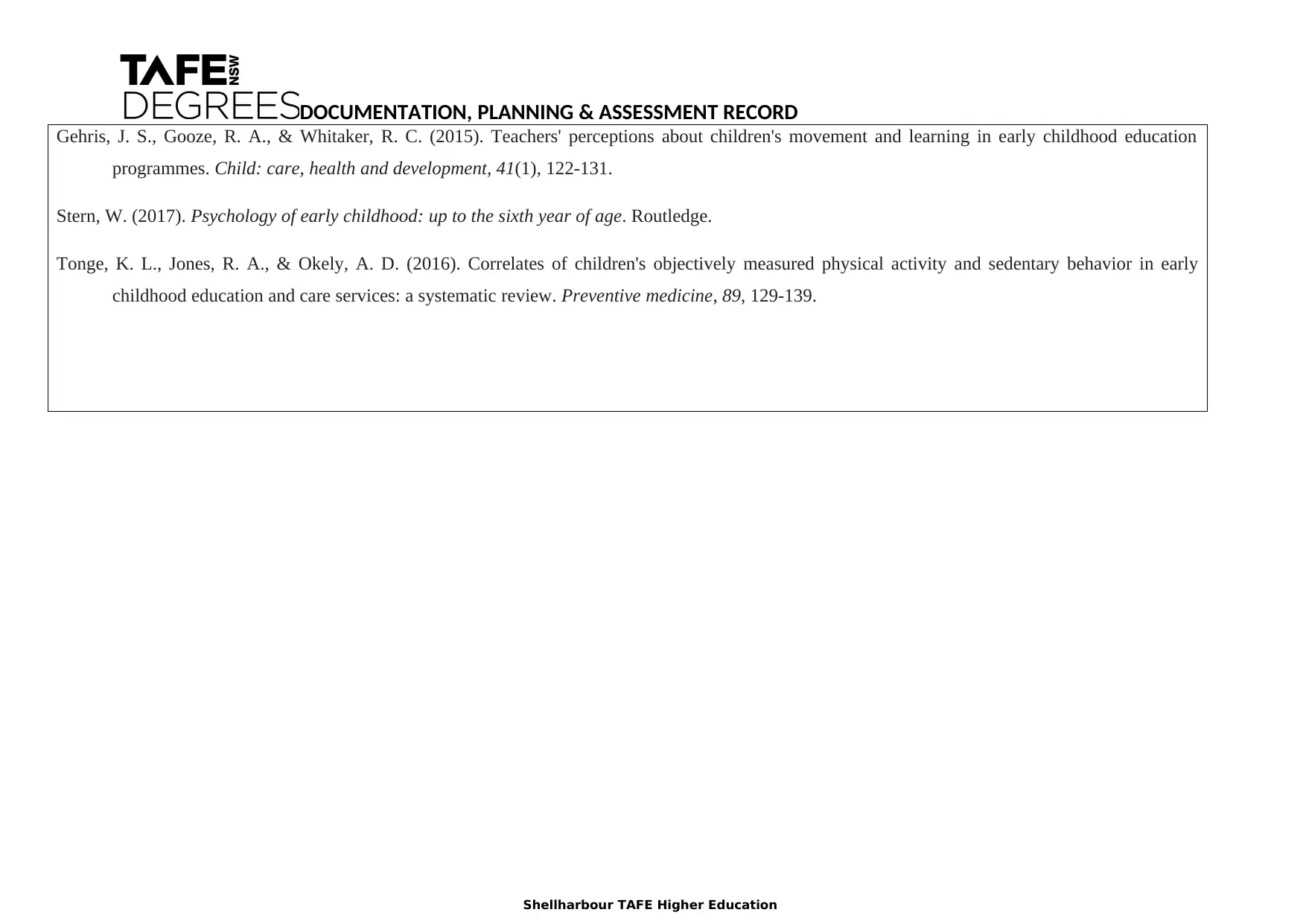
DOCUMENTATION, PLANNING & ASSESSMENT RECORD
Gehris, J. S., Gooze, R. A., & Whitaker, R. C. (2015). Teachers' perceptions about children's movement and learning in early childhood education
programmes. Child: care, health and development, 41(1), 122-131.
Stern, W. (2017). Psychology of early childhood: up to the sixth year of age. Routledge.
Tonge, K. L., Jones, R. A., & Okely, A. D. (2016). Correlates of children's objectively measured physical activity and sedentary behavior in early
childhood education and care services: a systematic review. Preventive medicine, 89, 129-139.
Shellharbour TAFE Higher Education
Gehris, J. S., Gooze, R. A., & Whitaker, R. C. (2015). Teachers' perceptions about children's movement and learning in early childhood education
programmes. Child: care, health and development, 41(1), 122-131.
Stern, W. (2017). Psychology of early childhood: up to the sixth year of age. Routledge.
Tonge, K. L., Jones, R. A., & Okely, A. D. (2016). Correlates of children's objectively measured physical activity and sedentary behavior in early
childhood education and care services: a systematic review. Preventive medicine, 89, 129-139.
Shellharbour TAFE Higher Education
1 out of 5
Your All-in-One AI-Powered Toolkit for Academic Success.
+13062052269
info@desklib.com
Available 24*7 on WhatsApp / Email
![[object Object]](/_next/static/media/star-bottom.7253800d.svg)
Unlock your academic potential
Copyright © 2020–2025 A2Z Services. All Rights Reserved. Developed and managed by ZUCOL.


